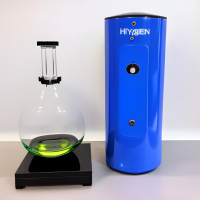Vynna Alviolina Indriyana
Contents
INTRODUCTION
Hi everyone! My name's Vynna, I'm a student in Numerical Method 1 Class. My student Number is 2106634036. Here, I'll upload my progress in the class. Hopefully through this page, I can increase my conscious learning and spread knowledges to readers.
CLASS SUMMARY
This content will be updated weekly after discussion meeting with Mr. Ahmad Indra Siswantara in class.
Numerical Method Use in Mechanical Engineering (22/5/2023)
In the class, we've been introduced to the concept of "I am my consciousness". We fully control our consciousness to think, learn, and act. It what makes us different from Artificial Intelligence. They may able to store large number of data, but we have consciousness that can utilize that data to solve real life problems. We've also been introduced to CCIT (Cara Cepat Ingat Tuhan). Nothing perfect in this world, except the Lord Allah SWT Himself. Our knowledge is just a speck of dust in this world, therefore we need to keep learning.
After that we start our discussion regarding numerical method use in mechanical engineering. I state my opinion : "I've been told by my lecturer in CAD/CAM class that we need numerical method as an approach of machine works. For example, the milling machine is programmed to machining at some exact points. But in the reality, no computer able to reach specific points. It uses numerical method approach to the point with error the tolerance number that has been set by operator."
Other students also stated their opinion and it can be sum up to these :
1. Program manufacture machines
2. Solve problems with lot of variables
3. Calculate real system simulation
4. Solve complex system that hardly solved by analytic method
5. Formulate mathematical model of system
CLASS ASSIGNMENT
All assignments here can be done with deep researching and help from Artificial Intelligence that elaborated with conscious thinking. References will be linked at the end of the quotes.
Design and Optimization of Compressed Hydrogen Storage
Compressed Hydrogen Storage
Compressed hydrogen storage is a method of storing hydrogen gas at high pressures to achieve a higher energy density and facilitate its use as a fuel. Hydrogen is an extremely lightweight gas and has a low energy density compared to liquid fuels, making it challenging to store and transport in large quantities. Compressing hydrogen gas increases its density and allows for more hydrogen to be stored within a given volume.
The process of compressed hydrogen storage involves using a high-pressure container, typically made of strong materials such as carbon fiber composites or metal alloys, to hold the hydrogen gas. The gas is compressed to pressures ranging from 3,000 to 10,000 pounds per square inch (psi), or even higher in some cases. These high pressures significantly increase the amount of hydrogen that can be stored within a given volume.
The compressed hydrogen storage system typically includes valves, pressure regulators, and safety devices to ensure safe handling and release of the stored hydrogen. When the compressed hydrogen is needed, it can be released from the storage container and used as a fuel for various applications, such as fuel cell vehicles or industrial processes.
One advantage of compressed hydrogen storage is that it allows for quick refueling or recharging, similar to refueling a conventional gasoline or diesel vehicle. However, it does require robust storage containers and can be associated with safety concerns due to the high pressures involved. It is essential to handle compressed hydrogen with caution to prevent leaks or ruptures.
It's worth noting that there are other methods of hydrogen storage, such as cryogenic liquid storage and solid-state storage, each with its own advantages and challenges. The choice of storage method depends on factors such as the intended application, infrastructure availability, safety considerations, and cost-effectiveness.
Specification Requirements
Required specifications of the case are 1 liter hydrogen capacity with 8 bar pressure and maximum cost 500,000 IDR
Optimized Design
Designing a compressed hydrogen storage system with specific cost constraints requires careful consideration of various factors. Here's a conceptual design for a 1-liter hydrogen storage system with an 8-bar pressure rating and a maximum cost of 500,000 IDR:
Storage Container:
Material: Carbon fiber composite
Volume: 1 liter
Pressure Rating: 8 bar (800 kPa)
Cost: Approximately 300,000 IDR (costs may vary)
Valves and Pressure Regulator:
High-pressure valve: To control the flow of hydrogen into and out of the storage container.
Pressure regulator: To regulate the hydrogen pressure to a safe and consistent level for usage.
Cost: Approximately 100,000 IDR (costs may vary)
Safety Devices:
Pressure relief valve: To prevent over-pressurization and ensure safety. Burst disc: A safety device that releases excess pressure in case of an emergency. Cost: Approximately 50,000 IDR (costs may vary) Piping and Connectors:
Stainless steel or high-pressure-rated tubing and connectors to ensure reliable hydrogen flow between components. Cost: Approximately 50,000 IDR (costs may vary) Installation and Labor:
Labor costs for assembling and installing the system. Cost: Approximately 100,000 IDR (costs may vary) Please note that the cost estimates provided are approximate and can vary depending on factors such as location, availability of materials, and labor costs. It's essential to consult with hydrogen storage system manufacturers or suppliers to obtain accurate cost estimates for your specific requirements.
Additionally, it's important to adhere to safety regulations and guidelines when designing, installing, and operating a compressed hydrogen storage system. Proper training and knowledge about hydrogen safety practices are crucial to ensure safe handling and operation of the system.

